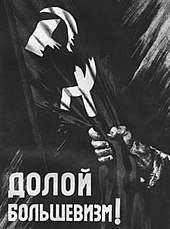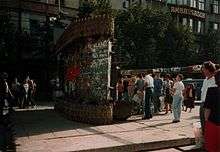Anti-Sovietism

.jpg)

Anti-Sovietism and anti-Soviet refer to persons and activities actually or allegedly aimed against the Soviet Union or government power within the Soviet Union.[1]
Three different flavors of the usage of the term may be distinguished.
- Anti-Sovietism in international politics, such as the Western opposition to the Soviet Union during the Cold War by anti-communism.
- Anti-Soviet opponents of Bolsheviks shortly after the Russian Revolution and during the Russian Civil War.
- As applied to Soviet citizens (allegedly) involved in anti-government activities.
Soviet Russia
During the Russian Civil War that followed the October Revolution of 1917, the anti-Soviet side was the White movement. Between the wars, some resistance movement, particularly in the 1920s, was cultivated by Polish intelligence in the form of the Promethean project. After Nazi Germany's attack on the Soviet Union, anti-Soviet forces were created and led primarily by Nazi Germany (see Russian Liberation Movement).
In the time of the Russian Civil War, whole categories of people, such as clergy, kulaks and former Imperial Russian police, were automatically considered anti-Soviet. More categories are listed in the article "Enemy of the people".
For many people, the major evidence of their guilt was their social status rather than actual deeds. Martin Latsis, chief of the Ukrainian Cheka, explained in a newspaper:
Do not look in the file of incriminating evidence to see whether or not the accused rose up against the Soviets with arms or words. Ask him instead to which class he belongs, what is his background, his education, his profession. These are the questions that will determine the fate of the accused.[2]
Later in the Soviet Union, being anti-Soviet was a criminal offense. The epithet "antisoviet" was synonymous with "counter-revolutionary". The noun "antisovietism" was rarely used and the noun "antisovietist" (Russian: антисоветчик, translit. antisovetchik) was used in a derogatory sense. Anti-Soviet agitation and activities were political crimes handled by the Article 58 and later Article 70 of the RSFSR penal code and similar articles in other Soviet republics. In February 1930, there was an anti-Soviet insurgency in the Kazak Autonomous Socialist Soviet Republic village of Sozak.[3]
After the end of the Second World War, there were Eastern European anti-Communist insurgencies against the Soviet Union.
See also
External Links
References
- ↑ Conquest, Robert (2007). The Great Terror. USA: Oxford University Press. pp. 28–29.
- ↑ Yevgenia Albats and Catherine A. Fitzpatrick. The State Within a State: The KGB and Its Hold on Russia - Past, Present, and Future, 1994. ISBN 0-374-52738-5.
- ↑ Niccolò Pianciola; Paolo Sartori (2013). "Interpreting an insurgency in Soviet Kazakhstan : the OGPU, Islam and Qazaq 'Clans' in Suzak, 1930". Islam, Society and States Across the Qazaq Steppe: 297–340.
